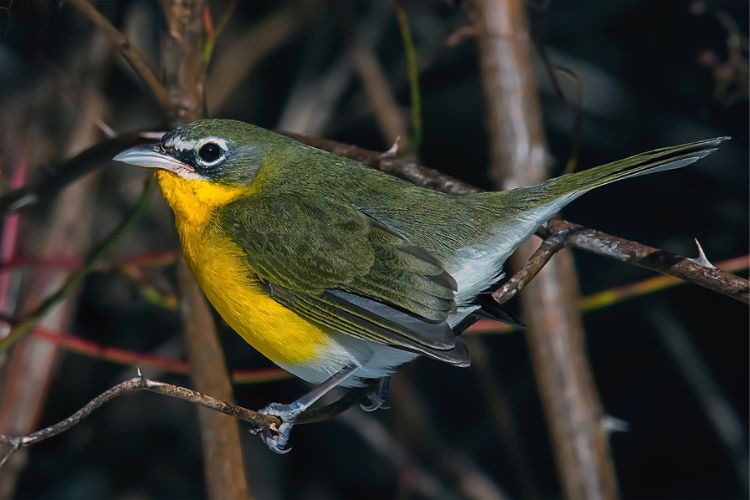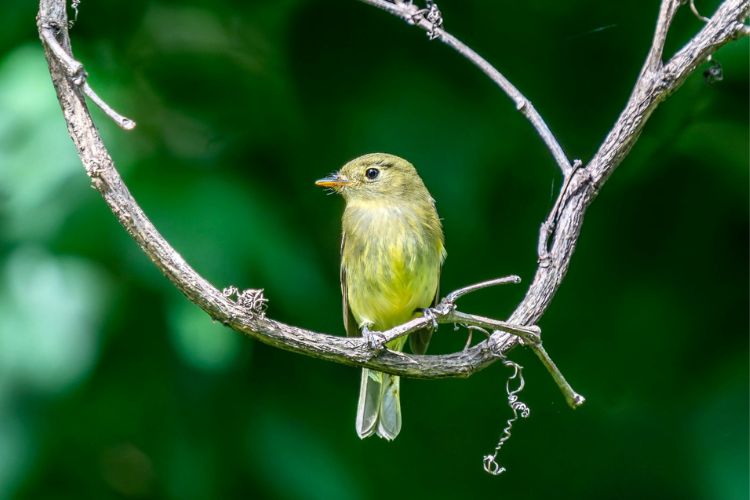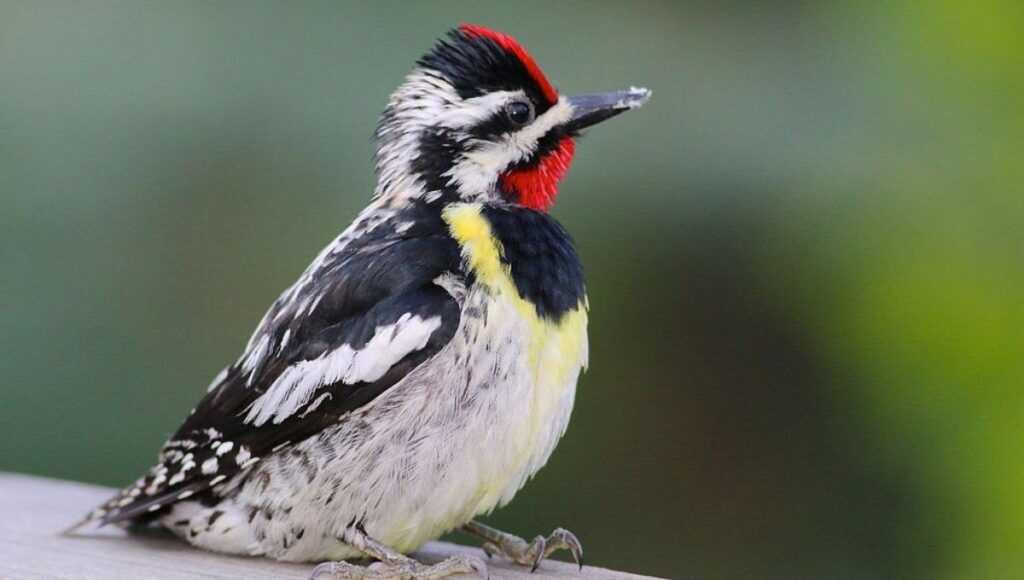In the vast Texan landscape, you will discover amazing yellow-belly birds. There are a total of 3 beautiful yellow-belly birds in Texas.
From the lively Yellow-bellied Sapsucker to the cheerful Yellow-breasted chat, these feathered friends bring color and melody to the Lone Star State.
They make their homes in woodlands, grasslands, and wetlands, and even visit your backyard.
1. Yellow-breasted Chat in Texas

Yellow-breasted Chats in Texas can be found in a variety of habitats, including thickets, shrubby areas, woodlands, and riparian zones. They prefer dense vegetation for nesting and foraging.
Size: Yellow-breasted Chats are about 7 to 8 inches (18-20 cm) in length and have a wingspan of 9.5 to 10 inches (24-26 cm).
Appearances: These birds have a distinctive appearance with bright yellow underparts, a white belly, and olive-green upperparts. They also sport a distinctive white eye ring and a long tail.
Diet: Yellow-breasted Chats have an omnivorous diet, feeding on insects, fruits, and berries. They are known to be opportunistic foragers, hunting insects and spiders while also consuming a variety of fruits.
Behavior: Chats are known for their secretive behavior and can be difficult to spot due to their preference for dense vegetation. They are often heard rather than seen, as they produce a range of loud and melodious calls.
Breeding Seasons: Breeding season typically occurs from late April to early August in Texas. During this time, they build nests and lay eggs.
Nest: Chats construct cup-shaped nests made of grass, leaves, and twigs, often placed in low vegetation or shrubs. Nests are well-hidden to protect them from predators.
Conservation Status: Yellow-breasted Chats are currently listed as a species of least concern. However, their populations can be affected by habitat loss and fragmentation.
Where to See in Texas: To spot Yellow-breasted Chats in Texas, visit areas with dense vegetation near water sources like rivers, streams, or wetlands. Ideal locations include wildlife refuges and state parks, such as the Anahuac National Wildlife Refuge, Big Thicket National Preserve, and Brazos Bend State Park.
[Ruby_E_Template id=”8192″]
2. Yellow-bellied Sapsucker in Texas

Habitat: Yellow-bellied Sapsuckers in Texas are often found in woodlands, forests, and mixed coniferous-deciduous woods. They prefer habitats with plenty of trees and are commonly spotted in urban areas with suitable tree cover.
Size: Yellow-bellied Sapsuckers are approximately 7-8 inches (18-20 cm) long with a wingspan of 13-16 inches (33-41 cm).
Appearances: These birds have a striking appearance, with a black and white striped head, a white belly, and a yellow tinge on their breast and belly. They also display distinctive white wing patches and a red patch on their throats (males) or foreheads (females).
Diet: Yellow-bellied Sapsuckers primarily feed on tree sap, which they obtain by drilling small, organized holes in the bark of trees. They also consume insects attracted to the liquid, as well as fruits and berries.
Behavior: Sapsuckers are known for their unique feeding behavior, drilling rows of holes in trees to access sap. They return to these “sap wells” to feed and also catch insects. They may occasionally visit hummingbird feeders for sugar water.
Breeding Seasons: Breeding season typically occurs from late April to early July in Texas. They build nests in tree cavities or nest boxes.
Nest: Yellow-bellied Sapsuckers create their nests in tree cavities, often using abandoned woodpecker holes. They may also utilize nest boxes if available.
Conservation Status: These sapsuckers are generally stable in population, and their conservation status is of most minor concern.
Where to See in Texas: You can find Yellow-bellied Sapsuckers in various parts of Texas, particularly in wooded areas, parks, and suburban environments with mature trees. Common locations for sightings include the Big Thicket National Preserve, Sabine Woods, and Big Bend National Park.
3. Yellow-bellied Flycatcher in Texas

Yellow-bellied Flycatchers in Texas inhabit dense coniferous and mixed forests, often near streams or wet areas. They are migratory birds and can be found during their breeding season in these wooded habitats.
Size: These flycatchers are small birds, measuring about 5.5 inches (14 cm) in length.
Appearances: Yellow-bellied Flycatchers have a subtle appearance with olive-green upperparts, pale yellow bellies, and a white eye ring. They also display a slight yellow wash on their throats.
Diet: Their diet mainly consists of insects, which they catch by flycatching – darting out from a perch to snatch flying insects.
Behavior: These birds are known for their quiet and unobtrusive behavior. They are often heard before they are seen due to their distinctive soft “pew” calls.
Breeding Seasons: In Texas, their breeding season typically spans from May to July.
Nest: Yellow-bellied Flycatchers build cup-shaped nests in trees, usually well-hidden in dense foliage. They use materials like twigs, moss, and grass to construct their nests.
Conservation Status: The conservation status of Yellow-bellied Flycatchers is of least concern, as they have stable populations.
Where to See in Texas: To spot Yellow-bellied Flycatchers in Texas, visit coniferous or mixed forests, particularly in the eastern and central parts of the state during their breeding season. Some suitable locations for sightings include the Sam Houston National Forest, Davy Crockett National Forest, and the Pineywoods region in general.
Conclusion
Yellow belly birds are a delightful and colorful addition to the Texan landscape. Their bright plumage and cheerful songs bring joy to all who see and hear them. These birds play an important role in the Texan ecosystem, and they are a valuable part of the state’s natural heritage.
Next time you are out in nature, keep an eye out for yellow-belly birds. You may be surprised at how many different species you can find. And if you are lucky enough to spot one, be sure to take a moment to appreciate its beauty and song.

